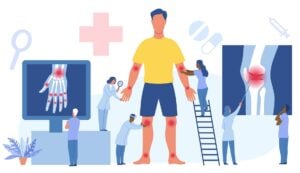

One of the most common causes of joint pain is Osteoarthritis (OA). It is one of the leading causes of chronic pain and disability worldwide. The most commonly affected joints are the knees, hips, ankles and hands (wrists, fingers). OA is most common in people over the age of 65.
Diagnosis of OA is primarily based on symptom presentation, medical history, physical examination of joints and reflexes, as well as an assessment of physical function and ability. X-rays may be helpful as they can show cartilage loss and bone damage and/or spurs. If X-ray results aren’t limited, magnetic resonance imaging (MRI) may be performed. MRI can reveal non-bony damage, such as ligament or connective tissue damage.
The most common symptoms of OA are:
Symptoms generally progress with age and activity.
The underlying cause of OA and symptom progression is multifactorial, depending on the patient and various contributing factors. Previously, it was believed simply to be caused by general mechanical wear and tear of the joints, however, it is now recognised as a degenerative disease of the joints with numerous risk factors.

The major contributing factors include:
Whilst there is no cure for OA, the symptoms are avoidable. There are numerous treatments and management strategies available that aim to alleviate OA associated pain, improve mobility and function, and slow its progression. The effectiveness of treatments differs between patients and depend on the location and grade of OA.
Over-the-counter analgesic medications include paracetamol, which has specifically demonstrated effectiveness for people with OA, and nonsteroidal anti-inflammatory drugs (NSAIDS), such as ibuprofen. For stronger pain relief, opioid medications (i.e. oxycodone and tramadol) may be prescribed by a physician, however, they are often associated with side effects. Topical analgesics (i.e. NSAIDS or opioids) may provide relief without the systemic side effects associated with oral medications.
Although research is somewhat limited, certain dietary supplements, such as chondroitin, glucosamine and Vitamin D, may help to reduce the progression or symptoms of OA.
Exercise is one of the most effective ways to manage OA. While it may be painful, light exercise has actually been shown to reduce pain. Strengthening the muscles around the affected joint can also reduce the pain. Increasing joint flexibility will help to regain motion in the joint. Exercise can also help with weight loss and maintenance. A physiotherapist can develop an individualised active exercise program to help a patient manage their OA. Studies also suggest that aquatic exercise may provide some benefit in terms of pain, disability and quality of life for OA of the knee or hip.
Joint injections (intra-articular), such as corticosteroids and hyaluronic acid, may improve pain and function. There is growing evidence to also support the use of platelet-rich plasma (PRP) and Botox injections.
In cases of severe, refractory OA pain, invasive surgery is an option and includes joint replacement and bone realignment.
An occupational therapist can assist with reducing the burden of home and work activities by developing ways to reduce the associated stress and pain. Assistive devices are also available to OA patients.
Genesis Research Services conducts clinical trials for a range of painful conditions. To view currently recruiting studies or register your interest for future studies, click here or call us on (02) 4985 1860.
View our currently recruiting studies:
Register your interest for future studies:
© Genesis Research Services, 2023